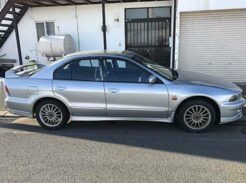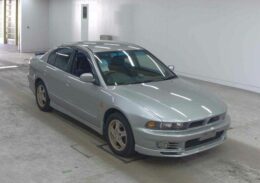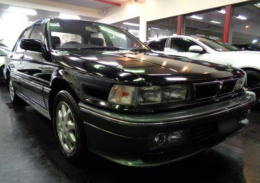
2007 Mitsubishi Galant Fortis Sprts PKG 2000cc AT 79K
Mitsubishi Galant Buying Guide
Mitsubishi was one of the biggest Japanese car manufacturers in the late 20th Century, but according to enthusiasts, that is not the case today. Not to say that they don’t make great cars; it’s just that they don’t make them like they used to. Companies like Mazda and Honda Couldn’t come close to what Mitsubishi did. They had great cars, especially tuner cars, such as the Mitsubishi GTO, Eclipse, and the recently discontinued Mitsubishi EVO, considered the best Mitsubishi ever made. But one of them has been forgotten and is very underrated, the Mitsubishi Galant, also known as the Mitsubishi Legnum.
The Mitsubishi Galant was introduced to the Japanese market in 1969 and was available as a coupe, sedan, and wagon, enabling Mitsubishi to compete evenly with other competitors such as Toyota. Because of its success in Japan, the Galant became Mitsubishi’s first car to be exported and sold in the United States. Due to their partnership with Mitsubishi, Chrysler Motors badge-engineered the Mitsubishi Galant and sold it under different names, such as the Dodge colt and Chrysler Sigma.
Unknown to many, the Mitsubishi Galant was the first to get the turbocharged 4G63T engine carried on to the EVO. For this reason, it was nicknamed the EVO Zero and is sometimes referred to as the EVO’s godfather. When Mitsubishi entered the Galant in the WRC, they produced an all-wheel-drive variant as a homologation car in 1987 known as the Galant/Legnum VR-4, which is the most desired Galant spec.
The Mitsubishi Galant has lived on US roads since its early years, but very little is known about it as it’s shadowed by the EVO and its biggest competitor, the Subaru Legacy. However, before you jump headfirst into buying one, it’s a great car, no lie; there are some factors you should know and consider, all of which are included in this guide.
Pros and Cons

Pros
Cheaper and More Practical
Very few JDM car buyers consider practicality which is the main reason the JDM car scene is mainly made up of sports cars than sedans and wagons. Those who buy sedans and wagons want something that has the best of the practicality and tunability worlds, and the Mitsubishi Galant has both. However, it’s still inexpensive, which makes it even more desirable. Prices start at approximately $5,000 for a standard rear-wheel-drive variant, while AWD variants retail for above $10,000.
Mitsubishi built the Galant on a more extended platform than the Mitsubishi EVO, which enabled them to produce it as a sedan and a wagon. In contrast, only the EVO 9 was made as a sedan and wagon. The Galant’s seating capacity might be the same as the EVO’s, but it has a larger trunk space, headroom, and legroom, and trunk space is even larger in the wagon. This makes it the perfect car for road trips and market runs that can embarrass any Miata owner who tries to hoon at you.
Running and Maintenance Costs
Owner reviews show that the Mitsubishi Galant has an average reliability rating of 3.5/5.0. But not all model years are reliable, and most current and previous owners recommend model years made between 1986 and 1995. But does it make the perfect beginner car or daily driven car? Well, it depends on the car’s condition, as the Mitsubishi Galant can be problematic, especially if you get a high mileage or a poorly maintained one.
Maintenance costs, especially when it comes to mechanicals, are not that high but are certainly not cheap compared to a Mazda Miata’s costs. Nonetheless, comparing the overall buying and maintenance costs, you still get value for money with a Mitsubishi Galant. Variants with naturally aspirated engines are the easiest to maintain, while those with turbocharged engines have higher maintenance costs. On the upside, some turbocharged engines in the Mitsubishi Galant are highly tunable.
Some Engines are Highly Tunable
When buying any JDM car, one of the significant mods most owners have planned is engine modification and tuning. But it’s impossible to do that on all engines since they come in different variants, with some being able to handle more power than others. Regardless, all are reliable and durable when stock, and that changes the moment the modifications begin. Here are some of the best tunable engines available in the Mitsubishi Galant.
Mitsubishi introduced the 4G63 engine to replace the 4G52 for the Mitsubishi Galant and other models such as the Lancer. They later made a DOHC turbocharged variant, the 4G63T, first used in the Galant before other models. Dubbed the 2JZ of the 4-cylinder engine world, the 4G63T is among the most straightforward engines to tune and modify. However, it takes deeper pockets and patience to tune older variants.
The only downside with tuning the 4G63T in the Mitsubishi Galant is that it’s detuned. But this does not mean that it isn’t as capable. Some owners only go as far as modifying with EVO-borrowed parts such as the oil pump, injectors, and intakes, then upgrading the turbo and turbo manifold. Some variants have a plastic blow-off valve that should be upgraded to metal to handle more boost. Rebuilding the engine with forged internals and aftermarket peripherals is the best road to over 400 horsepower and maybe a four-figure power output.
The 4G63T didn’t live long before the 6A12TT, a twin-turbo V6 with a similar 2.0-liter displacement, replaced it in 1992. However, it was only used in the AWD spec, which is also the case for the 2.5-liter twin-turbocharged 6A13TT. Both engines are similar in build structure. Apart from the displacement, the 6A13TT makes 280 horsepower without any mods compared to 240 horsepower in the 6A12TT.
Common mods on the twin-turbo V6 engines include upgrading to bigger turbos or a single turbo setup, ECU remapping, and upgrading the thin rods to thicker ones. Maximum power output is the same as the 4G63T, approximately 400 horsepower, with factory internals despite having two more cylinders.
Pleasing To Look At
One thing about old JDM cars, they never miss showing up looking good at the party, and the Mitsubishi Galant is no exception. It’s not as long as a Toyota Chaser but not as short as a Mitsubishi EVO; it has the perfect wheelbase. Even early generations still look mint today, especially the coupes. If looks are a priority, get a Galant made between 1987 and 2006.
A few tasteful mods, such as good wheels, a neat paint job, and an EVO-inspired wing, will have you looking back at a Mitsubishi Galant severally every time you park it or come across one, especially if it’s a wagon. Every car owner and enthusiast does that, but a car has to have something special to have you look back at it more than once. Jeremy Clarkson himself found the Galant’s styling terrific. He said, “It’s like one of those women who, when you first meet them, don’t appear attractive at all. But after a few hours, you’re at her feet, slobbering.”
Exciting To Drive
Driving a Mitsubishi Galant, especially one with a turbocharged engine, will put a grin on your face stretching from ear to ear. You fall in love the first time you put that throttle down, and by the time you’re getting to third gear, the decision to buy it has already been cemented. The only disadvantage compared to the Mitsubishi EVO is that the Mitsubishi Galant is heavier and base-sped variants made after 1983 are front-wheel-drive, but that weight helps it stick onto the road.
AWD variants have AYC (Active Yawn Control), which works similarly to an active LSD by transferring torque to either rear wheel with the most grip. Feathering the throttle will have the car effortlessly sliding around corners, and if that’s your driving pleasure, you’ll enjoy the Mitsubishi Galant. Perhaps even turn it into a drift car.
Cons

Strenuous To Work On
The Mitsubishi Galant with a V6 engine isn’t as easy to work compared to one with a 4-cylinder engine. Getting work done in the engine bay takes hours and might require engine removal for something as simple as a camshaft belt change. Due to the same reason, maintenance is also expensive as most mechanics are either inexperienced in working on the car or will spend too much time working on the vehicle. However, scraping parts from other Mitsubishis, such as the EVO and Lancer, and Dodges, such as the Dodge Magna and Starion, is easy.
Poor Build Quality
One of the biggest cons of JDM cars is their poor build quality. Sure, it can be blamed on old age and constant use and abuse, but in some, it’s evident that poor build quality can be blamed on the manufacturer, not only the previous owners.
When buying a Mitsubishi Galant, inspect the condition of the paint by checking for cracks and chips while feeling the thickness of the paint. Some owners will repaint over a rust spot without removing the rust first, thus causing uneven thickness. Other common rust spots on the Mitsubishi Galant include the trunk, engine bay, and underneath. Also, check the condition of the weather trims, especially on doors, that might cause water to seep in and accumulate.
Common Issues
High Fuel Consumption and Oil Leaks
Such issues on old JDM cars are unavoidable and can’t be fixed 100%. However, some owners have attributed excessive fuel consumption to a faulty throttle body. This might happen in any Mitsubishi Galant, but throttle body failure is common in V6 engine variants. It clogs up with dirt and grime and becomes faulty due to aging. Also, the electricals on older Mitsubishis aren’t that great and might cause throttle body failure.
Replacing or cleaning the throttle body and its wiring easily solves excessive fuel consumption, but it’s not guaranteed to be the same as when new. On top of that, check if the fuel tank gauge reading is correct since it can be faulty on some model years.
Oil leaks on the Mitsubishi Galant are mainly from the driveshaft seal and worn-out or wrongly-seated piston rings. If oil is leaking from the driveshaft seal, the first sign you’ll notice is an oil patch on the ground after parking the car for an extended period. This happens if the shaft is loose due to improper installation or normal wear and tear, as it causes seal damage. The driveshaft’s condition determines whether it must be replaced with a new seal, and a new seal lip should also be installed.
Faulty or wrongly placed piston rings allow oil to leak into the combustion chamber, thus resulting in what is called “burning oil,” characterized by white smoke and spluttering. Depending on the oil rings’ bad, there might be a loss of power due to insufficient compression in the combustion chamber. Replacing the oil rings must be done carefully, not bending or breaking them during installation.
Front Suspension Issues
A front suspension overhaul is one of the first upgrades most Mitsubishi Galant and Legnum owners recommend even before working on the engine. Common faulty front suspension components include the control arms, bushings, and wheel hub assembly. The control arms are bound to develop issues first, resulting in a loud clunking or popping sound when cornering or going over bumps. Uneven tire wear also indicates beat-up control arms. Luckily replacing the control arms is easy, but they should be replaced with the bushings.
The Mitsubishi Galant’s poor build quality also extends to mechanical components such as the wheel hub assembly, which are meant to last through the car’s lifetime. It cannot be explained how they break, but once they do, the wheel hubs need to be replaced immediately. Maybe even consider swapping to 5-lug nut hubs if you have an older Galant with 4-lug nut hubs. Other components you should inspect on the front suspension include U-joints, ball joints, and the engine mounts, which are not suspension related but should be checked for safety purposes.
Automatic Transmission Failure
Transmission failure is common in Mitsubishi Galants with an automatic regardless of the model year. There’s something about automatic transmissions not belonging to sports cars and sedans. Most owners will swap to a manual transmission almost immediately after buying one with an automatic transmission.
But if that’s your choice, you should know that servicing must be done regularly, and fitting a cooler might increase the transmission’s lifespan by preventing overheating. Swap to a manual transmission if modifying and tuning the engine is on your bucket list since the automatic transmission can’t handle enthusiastic driving.
Causes of automatic transmission failure vary from minors, such as transmission fluid leaks and normal gear wear on high mileage cars, to broken transmission bands and clutch failure. Repairing the transmission will almost cost as much as you paid for the car, and swapping with a manual transmission or a better automatic is recommended.
AYC Pump Issues
Just like the Mitsubishi EVO, the Mitsubishi Galant has an Active Yawn Control (AYC) system, but only in AWD variants, which acts like an active LSD. Mitsubishi claims it’s better than a traditional active LSD as it affects speed through the corners, unlike the LSD, which affects speed only when entering a corner but not so much when exiting a corner.
The AYC system is flawless throughout its entire design except for the AYC pump. Over time rust accumulates in the pump, eating away internals which de-pressurizes the system. The pump’s internals also jam against each other if corrosion occurs, the wrong AYC pump fluid is used, or the car is left out for extended periods during the winter. AYC pump failure is so common in AWD Mitsubishis that most sellers will indicate pump failure in the sale details. If they don’t and the pump is already out, you’ll notice difficulty accelerating and losing grip when cornering or driving on a loose surface.
Experts recommend replacing the AYC pump on Mitsubishis, including the Galant, with a new one instead of rebuilding the old one. This can be done with new internals, such as the bearings and sandwich plate, but a rebuilt AYC pump will not last longer than a new one.
Average Prices

If a reasonably fast JDM sedan or wagon has been on your bucket list for a while, why not get a Mitsubishi Galant? Prices start at approximately $5,000 for RWD and FWD variants, while AWD variants sell for a $10,000 minimum. Luckily you can get one listed for lower than retail prices if it’s locally used or the seller has listed some faults with the car. Rare spec Galants, such as the Type II Galant AMG, of which 500 units were made, are also not overpriced. For example, one Galant AMG sold for $8,900 on Bring A Trailer two years ago.
What To Look For When Buying A Mitsubishi Galant
Since the Mitsubishi Galant might be challenging to work on, check for poorly done or half-done repairs. Sometimes the seller gives a discount and throws in parts in the deal if you find such issues. But try and negotiate lower depending on how the repairs are done. There are some minor issues not listed that you should check for when buying a Mitsubishi Galant. For example, some models have plastic radiator top tanks that crack, causing coolant leaks. It might be in good condition but inspect it for weak spots.
On some owner forums, owners state that the Mitsubishi Galant might not pass the emission test due to a faulty catalytic converter. It helps if the previous owner has replaced the old catalytic converter, especially if you’re in a state with strict emission laws. A sulfuric smell from the exhaust is the best way to gauge if the catalytic converter is done with, and sometimes black smoke.
When taking the car for a test drive, feel the brakes as the master cylinder and brake booster can be problematic in old cars. A stiff or spongy brake pedal indicates faults in the braking system. Lastly, like when buying any other vehicle, ensure the title is clean and get a detailed maintenance record if possible.
Comparable Alternatives
- Subaru Legacy (Buying Guide)
- Mitsubishi Lancer (Buying Guide)
- Toyota Altezza (Buying Guide)
- Honda Accord
- Honda Orthia
- Nissan Laurel
- Mazda 626
Models and Specifications
1969-1973 Mitsubishi Galant (A50, A53)

When Mitsubishi unveiled the first-gen Galant, it was only available as a coupe (A50). The wagon and sedan variants (A53) entered production in 1970. You get the A50 and A53 eclipse with a 1.3-liter, 1.4-liter, 1.5-liter, 1.6-liter, or 1.7-liter engine driving the rear wheels via a 3-speed automatic or 4-speed manual transmission. Sportier models such as the 1600gs have extra styling features such as chrome bits on the bumpers, chrome badges, and fake louvers on the rear fenders.
1973-1976 Mitsubishi Galant (A112-A115)

There’s not much difference between the second-gen Mitsubishi Galant and the first-gen, as it was produced when the first-gen was still in production. It was more of a facelift since Mitsubishi adopted the “coke bottle” styling, which gave the Mitsubishi Galant a smooth curvy body. Transmission options are similar to the ones in the first-gen Galant. However, the second-gen was sold with a 1.6-liter or two 2.0-liter engine variants as the only engine options.
1976-1982 Mitsubishi Galant (A120, A130)
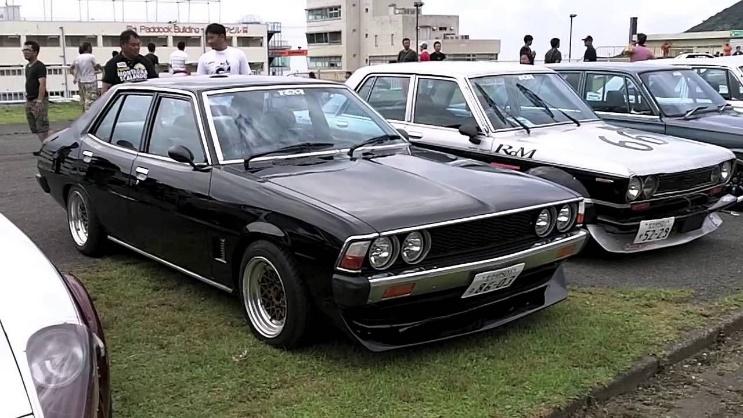
Like its predecessors, Mitsubishi made the third-gen Galant as a coupe, wagon, and sedan. In 1976, Mitsubishi used the first-turbocharged engine, a 2.0-liter 4G52T, in the Mitsubishi Galant, but it was only available for the Australian market. Other markets, including US and Japan, got the Galant with the same 1.6-liter and 2.0-liter engine used in the second generation in addition to a 2.5-liter engine. Buyers could either opt for a 4/5-speed manual transmission or a 3-speed automatic.
1980-1987 Mitsubishi Galant (A160)
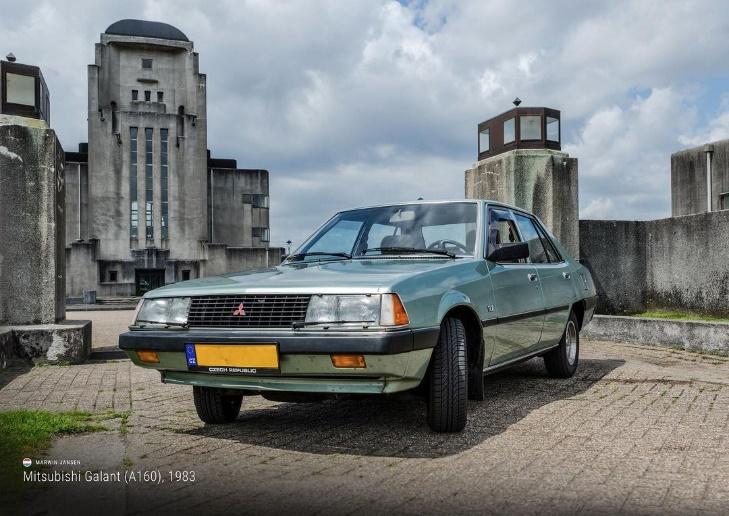
1980 is probably the most significant year for the Mitsubishi Galant as it was when Mitsubishi unveiled the infamous 2.0-liter turbocharged 4G63T. However, only units sold in Japan got it, and the Australian-spec Galant was still using the old 4G52T. Other fourth-generation Galant engines include a 1.6-liter and 1.8-liter engine and naturally aspirated versions of the turbocharged engines. A 4-speed transmission was made optional alongside the 3-speed and 4/5-speed manual transmission. Sadly, Mitsubishi discontinued the rear-wheel-drive platform for the Mitsubishi Galant, but something even more exciting entered production later in 1987.
1983-1989 Mitsubishi Galant (E11-E19)
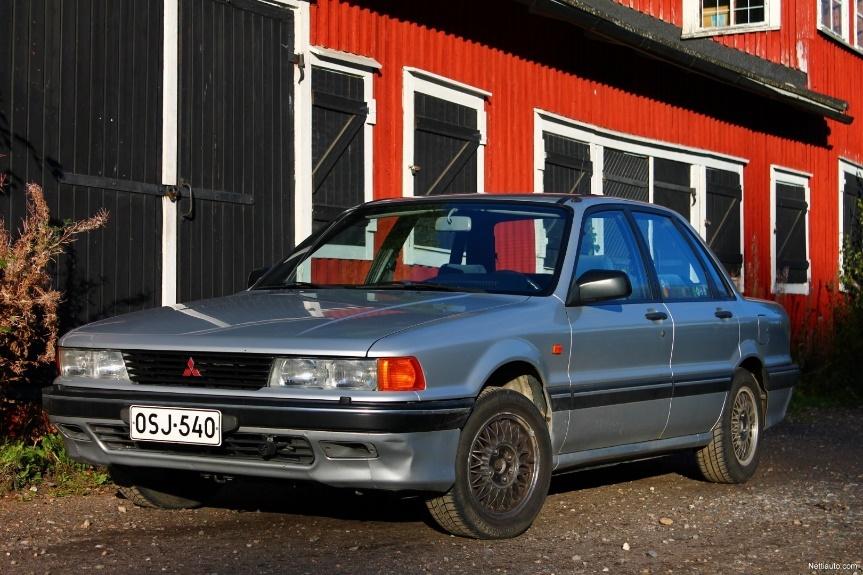
The fifth-gen Mitsubishi Eclipse is probably the most boring generation, mainly because Mitsubishi discontinued the rear-wheel-drive platform and hadn’t released the VR-4 spec yet. All engines used in the previous generation were retained except the turbocharged 4G52T, which Mitsubishi replaced with a 2.0-liter and 3.0-liter V6 engine. Transmission options were carried over from the fifth-gen Galant, but the 4-speed manual was replaced by a 4×2-speed Super Shift manual transmission similar to the one used in old trucks. For this reason, Mitsubishi made the fifth-gen Galant with a front-wheel-drive platform since the Super Shift Transmission couldn’t be used on RWD cars.
1987-1994 Mitsubishi Galant (E31-E39)
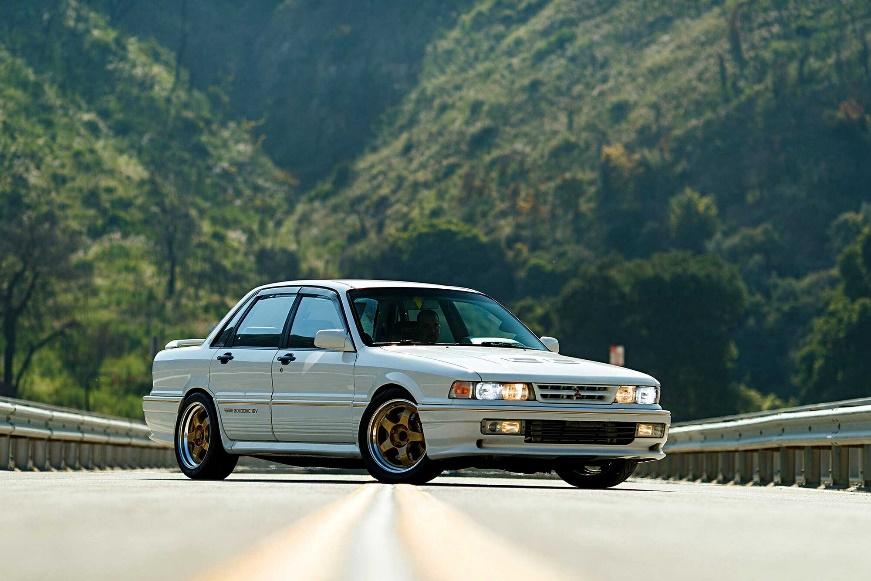
Since they started rallying, Mitsubishi entered the sixth-gen Galant in the WRC as their third car in 1987. But it was not just any ordinary Galant. The Galant used in Group A racing had the turbocharged 4G63T, which made over 300 horsepower sending power to all four wheels. It also had four-wheel-steering (4WS); thus, it attracted much attention in the rallying scene. Due to WRC regulations, Mitsubishi produced homologation cars for the WRC Galant with the same engine mated to a 4-speed automatic or 5-speed manual transmission sold as the Galant VR-4.
Base spec variants got the naturally aspirated 4G63 engine and two 1.8-liter engine variants coupled to the same transmission options as the VR-4 spec. Unknown to many the sixth-gen Galant got AMG treatment, but only 500 units were produced in collaboration with Mitsubishi and AMG. The Galant AMG was the second Mitsubishi that received AMG treatment after the Debonair V3000 AMG.
Power was amped up to 170 in the Galant AMG from the 4G63T compared to the VR-4’s 143 horsepower. It also got special touches such as a wide body kit, wooden trims in the interior, and new wheels, and you can’t miss the AMG badges if you happen to come across one.
1992-1998 Mitsubishi Galant (E52-E88)

The seventh-gen Mitsubishi Galant was unveiled in 1992 at the Tokyo Motor show, and when it went into production, it had more V6 engine options than previous generations. You get the 7G Galant with a 1.8-liter, 2.0-liter, or 2.5-liter engine, all V6 engines. Four-cylinder engines with similar displacements were also used, but the largest is a 2.4-liter. Like its predecessor, Mitsubishi retained the FWD platform, 4-speed automatic, and 5-speed manual transmission.
Mitsubishi discontinued the 4G63T in the Mitsubishi Galant, but it was still used in the EVO. The Galant was no longer in the WRC. Thus, WRC homologation restrictions were lifted, enabling Mitsubishi to use a more powerful 2.0-liter twin-turbo V6 in the Galant VR-4. Power output was rated at 240 horsepower making the Galant VR-4 one of the most powerful cars of its time. Mitsubishi went against the gentlemen’s agreement of 1988 and limited the VR-4’s speed to 240km/h, but it was still electronically limited.
1996-2006 Mitsubishi Galant (EA1-EA7, EC1-EC7)
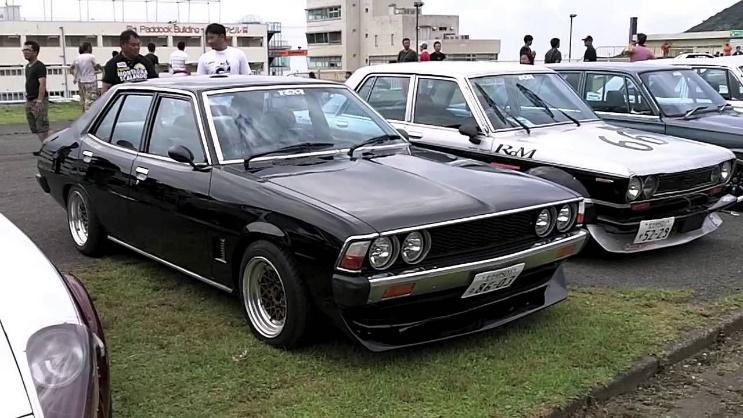
1992 saw the return of the Galant wagon sold as the Mitsubishi Legnum in Japan. The powertrain used in the seventh-gen Galant was carried over into the eighth-gen with the addition of a 1.8-liter GDI engine. Mitsubishi also introduced a 2.5-liter V6 and 3.0-liter V6 to replace the old V6 engines and 2.5-liter twin-turbo V6 used in the Mitsubishi Galant/Legnum VR-4. However, the Legnum had an optional 5-speed automatic transmission which was not available in the base model Galant.
2003-2012 Mitsubishi Galant, PS platform
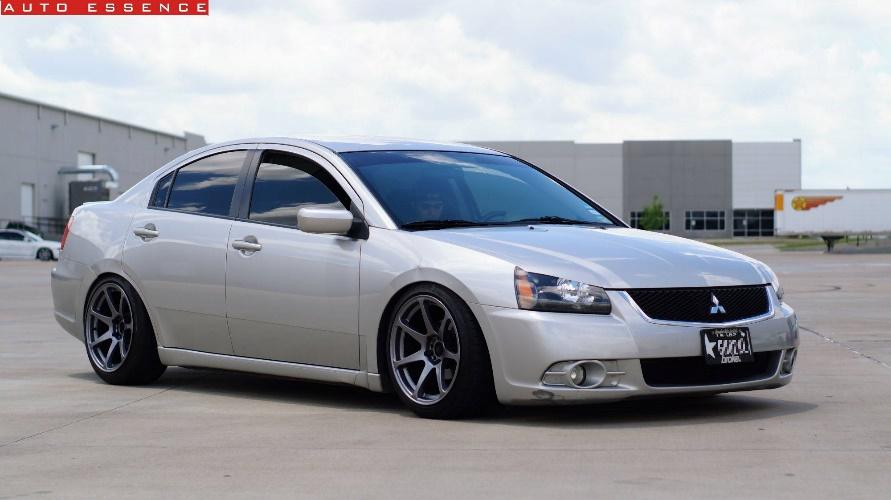
The last generation Mitsubishi Eclipse was produced in the United States, like other Mitsubishis using the PS platform, which Mitsubishi Motors North America developed. It’s also known as the Project America platform. For this generation, production was scaled down as only two engine options were available, a 2.4-liter 4-cylinder and a 3.8-liter V6 driving the front wheels via a 4-speed or 5-speed automatic transmission. Mitsubishi didn’t make an AWD variant of the 9G Galant, but the eighth-generation Galant/Legnum VR-4 was still in production and was discontinued in 2006.
FAQ
The Mitsubishi Legnum is the eighth-generation wagon variant of the Mitsubishi Galant. There’s no difference between the Galant and the Legnum, only that the Legnum name was used more in the Galant AWD spec known as the Mitsubishi Legnum VR-4.
Mitsubishi used a rear-wheel-drive platform for the Galant until 1987 when they switched to a front-wheel-drive platform. All Galants made after 1987 are front-wheel-drive except the VR-4 spec Galants.
VR-4 is Mitsubishi’s all-wheel-drive system which means Viscous Real-time four-wheel-drive.
The Mitsubishi Galant is a JDM car that Mitsubishi exported and sold in other markets, including the United States and Canada. However, the ninth-gen Galant was manufactured by Mitsubishi Motors North America in Normal, Illinois, North America.
Like any other car, Mitsubishi Galant Prices Vary depending on the spec and YOM, though there’s not much difference between prices. For example, you’ll get a well-maintained base spec model with maybe a 2.0-liter 4G63 listed for $7,000 and a VR-4 with the turbocharged 4G63T listed for a similar price or lower price. However, newer VR-4s sell for slightly higher, but prices rarely go above $20,000.
The first-generation Galant VR-4, 1987-1994, based on the sixth-gen Galant, has a 2.0-liter turbocharged engine (4G63T). Its predecessor, 1992-1998, has a 2.0-liter twin-turbo V6 (6A12TT), while the last-gen VR4, 1996-2006, has a 2.5-liter twin-turbo V6 (6A13TT).
How to Import a Mitsubishi Galant
Read our Ultimate Guide on How to Import a Car from Japan
